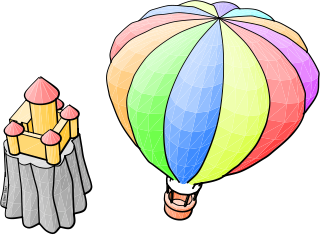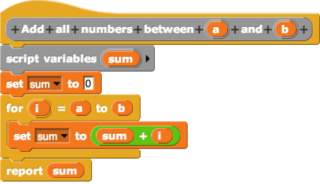
Smalltalk is a purely object oriented programming language (OOP), created in the 1970s for educational use, specifically for constructionist learning, at Xerox PARC by Learning Research Group (LRG) scientists, including Alan Kay, Dan Ingalls, Adele Goldberg, Ted Kaehler, Diana Merry, and Scott Wallace.
In computing, cross-platform software is computer software that is designed to work in several computing platforms. Some cross-platform software requires a separate build for each platform, but some can be directly run on any platform without special preparation, being written in an interpreted language or compiled to portable bytecode for which the interpreters or run-time packages are common or standard components of all supported platforms.
The Foundation for Intelligent Physical Agents (FIPA) is a body for developing and setting computer software standards for heterogeneous and interacting agents and agent-based systems.
Message-oriented middleware (MOM) is software or hardware infrastructure supporting sending and receiving messages between distributed systems. MOM allows application modules to be distributed over heterogeneous platforms and reduces the complexity of developing applications that span multiple operating systems and network protocols. The middleware creates a distributed communications layer that insulates the application developer from the details of the various operating systems and network interfaces. APIs that extend across diverse platforms and networks are typically provided by MOM.
In computer science, a software agent or software AI is a computer program that acts for a user or other program in a relationship of agency, which derives from the Latin agere : an agreement to act on one's behalf. Such "action on behalf of" implies the authority to decide which, if any, action is appropriate. Some agents are colloquially known as bots, from robot. They may be embodied, as when execution is paired with a robot body, or as software such as a chatbot executing on a phone or other computing device. Software agents may be autonomous or work together with other agents or people. Software agents interacting with people may possess human-like qualities such as natural language understanding and speech, personality or embody humanoid form.

In computing, a visual programming language or block coding is a programming language that lets users create programs by manipulating program elements graphically rather than by specifying them textually. A VPL allows programming with visual expressions, spatial arrangements of text and graphic symbols, used either as elements of syntax or secondary notation. For example, many VPLs are based on the idea of "boxes and arrows", where boxes or other screen objects are treated as entities, connected by arrows, lines or arcs which represent relations.

A multi-agent system is a computerized system composed of multiple interacting intelligent agents. Multi-agent systems can solve problems that are difficult or impossible for an individual agent or a monolithic system to solve. Intelligence may include methodic, functional, procedural approaches, algorithmic search or reinforcement learning.
In computer science, message passing is a technique for invoking behavior on a computer. The invoking program sends a message to a process and relies on that process and its supporting infrastructure to then select and run some appropriate code. Message passing differs from conventional programming where a process, subroutine, or function is directly invoked by name. Message passing is key to some models of concurrency and object-oriented programming.
Cougaar is a Java agent architecture.
In computing and systems design, a loosely coupled system is one
- in which components are weakly associated with each other, and thus changes in one component least affect existence or performance of another component.
- in which each of its components has, or makes use of, little or no knowledge of the definitions of other separate components. Subareas include the coupling of classes, interfaces, data, and services. Loose coupling is the opposite of tight coupling.
Agent Communication Language (ACL), proposed by the Foundation for Intelligent Physical Agents (FIPA), is a proposed standard language for agent communications. Knowledge Query and Manipulation Language (KQML) is another proposed standard.
ARINC 661 is a standard which aims to normalize the definition of a Cockpit Display System (CDS), and the communication between the CDS and User Applications (UA) which manage aircraft avionics functions. The GUI definition is completely defined in binary Definition Files (DF).

JADE is a proprietary object-oriented software development and deployment platform product from the New Zealand-based Jade Software Corporation, first released in 1996. It consists of the JADE programming language, Integrated development environment and debugger, integrated application server and object database management system.
IBM App Connect Enterprise is IBM's premier integration software offering, allowing business information to flow between disparate applications across multiple hardware and software platforms. Rules can be applied to the data flowing through user-authored integrations to route and transform the information. The product can be used as an Enterprise Service Bus supplying a communication channel between applications and services in a service-oriented architecture.
Knowledge Discovery Metamodel (KDM) is a publicly available specification from the Object Management Group (OMG). KDM is a common intermediate representation for existing software systems and their operating environments, that defines common metadata required for deep semantic integration of Application Lifecycle Management tools. KDM was designed as the OMG's foundation for software modernization, IT portfolio management and software assurance. KDM uses OMG's Meta-Object Facility to define an XMI interchange format between tools that work with existing software as well as an abstract interface (API) for the next-generation assurance and modernization tools. KDM standardizes existing approaches to knowledge discovery in software engineering artifacts, also known as software mining.
JACK Intelligent Agents is a framework in Java for multi-agent system development. JACK Intelligent Agents was built by Agent Oriented Software Pty. Ltd. (AOS) and is a third generation agent platform building on the experiences of the Procedural Reasoning System (PRS) and Distributed Multi-Agent Reasoning System (dMARS). JACK is one of the few multi-agent systems that uses the BDI software model and provides its own Java-based plan language and graphical planning tools.
Agent-oriented programming (AOP) is a programming paradigm where the construction of the software is centered on the concept of software agents. In contrast to object-oriented programming which has objects at its core, AOP has externally specified agents at its core. They can be thought of as abstractions of objects. Exchanged messages are interpreted by receiving "agents", in a way specific to its class of agents.
Middleware is a type of computer software that provides services to software applications beyond those available from the operating system. It can be described as "software glue".
Enduro/X is an open-source middleware platform for distributed transaction processing. It is built on proven APIs such as X/Open group's XATMI and XA. The platform is designed for building real-time microservices based applications with a clusterization option. Enduro/X functions as an extended drop-in replacement for Oracle Tuxedo. The platform uses in-memory POSIX Kernel queues which insures high interprocess communication throughput.
MaSMT is a free, lightweight Multi-agent system development framework, design through the Java environment. The MaSMT3 framework provides three types of agents, namely ordinary agent and managing agent and root agent. The managing agent capable to handle set of ordinary agent and the root agent capable to handle set of manager agents. MaSMT3.0 includes few features than the previous versions. MaSMT 3.0 includes root agent to handle swam of agents, Environment handling features to dynamically store agent's ontology, and notice board has been introducing to see required messages and events. In addition to these main features, agent status monitor has been introducing to view transporting messages. Multi-agent technology is modern software palindrome that capable of handling the complexity of a software system and providing intelligent solutions through the power of agent communication. A framework is a useful tool to develop multi-agent system and it saves lot of programmer's time and provides standards for the agent development.



